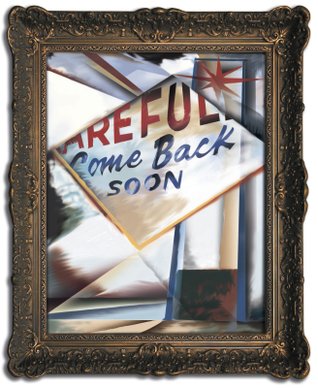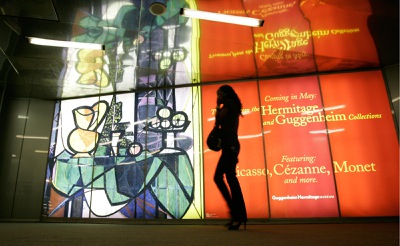Thursday, April 10, 2008 | 2 a.m.
Beyond the Sun
After nearly seven years on the Strip, the Guggenheim Hermitage Museum in the Venetian will close its doors May 11.
Guggenheim officials made the announcement Wednesday and said the museum will continue to partner with the Venetian on “a number of projects,” but wouldn’t elaborate. The museum will offer free admission beginning Friday until it closes in May.
With the closure — and Steve Wynn’s dismantling of his own fine arts gallery — the only remaining Strip art gallery is at the Bellagio, where the effort to bring fine art to the Las Vegas masses began in 1998.
The Guggenheim Hermitage’s closure comes as no surprise to the art community. Rumors of its demise began circulating in February 2007 when the Venetian took over daily operation of the museum. Some say the museum’s future always seemed a little sketchy because its programming was uncertain. There was also the nagging issue that the nonprofit museum was housed in the for-profit Venetian.
The final hint came in February when Thomas Krens, director of the Solomon R. Guggenheim Foundation and the man responsible for expanding the Guggenheim, including to Las Vegas, stepped down. “The contract has come to an end and it’s really that simple,” said Eleanor Goldhar, spokeswoman for the foundation. “I don’t think it’s a question of not wanting to renew the contract so much as we did what we set out to do and the hotel is going to be using the space differently.”
Venetian officials did not return a call seeking comment Wednesday.
“It’s a big loss to not have the great works of art on display and in our community,” said Libby Lumpkin, executive director of the Las Vegas Art Museum. “They put on a great education program that will be missed. But every museum depends on community support. The Guggenheim strove to connect with this community, to raise money within this community. That’s difficult when it’s in a private space. I knew that the Venetian was not as pleased with the success of the space as it had hoped to be.”
The Guggenheim opened two Las Vegas museums designed by Rem Koolhaas in October 2001. The Guggenheim Hermitage, a partnership between the Solomon R. Guggenheim Foundation and the State Hermitage Museum in St. Petersburg, Russia, was the smaller of the two. The 63,700-square-foot Guggenheim Las Vegas closed its doors 15 months later because of lack of funds and low attendance. Its only show was “The Art of the Motorcycle.”
The Guggenheim Hermitage continued to tap the resources of the Guggenheim and the Hermitage museums, bringing in 10 major exhibits in seven years. Shows featured works by Lichtenstein, Johns, Oldenburg, Rauschenberg, Wesselmann, Beckmann, Degas, Picasso, Rubens, Miro, Chagall, Bonnard, Kandinsky, Modigliani and Klee.
Despite the big names and its educational outreach led by Managing Director Elizabeth Herridge, the museum had a reputation for being a second thought by the larger Guggenheim foundation.
“It was always up in the air, of what the next show would be,” said Michele Quinn, who oversees art programs for MGM Mirage, including the Bellagio Gallery of Fine Art. “It seemed more like an afterthought type of program rather than a strong vision of what that space could be.”
Lumpkin said, “Among cultural tourists there is an expectation of seeing exhibitions that organize new knowledge with the works of art. At Guggenheim, it was more like showcasing great paintings.”
Critics say Guggenheim representatives never bothered to understand the Las Vegas community and mounted last-minute efforts here.
Local art collector Patrick Duffy, who donated a Fletcher Benton to the Guggenheim Foundation in Las Vegas’ name, has long been disappointed in the Guggenheim’s Las Vegas efforts and said New York neglected Las Vegas because it didn’t generate money for the organization.
“You don’t get a return on investment if you overpromise and underdeliver,” Duffy said.
Goldhar disagreed with the contention that New York didn’t care about Las Vegas.
“We sent our finest collections, our masterpieces,” she said, “masterworks that we committed to long periods of time in Las Vegas, things that were not available for loan to other museums anywhere in the world or even for us. I think that’s a pretty profound commitment to very high standards of exhibition in Las Vegas in a space designed by one of the world’s leading architects. I don’t see how that can be interpreted to anything but caring. Seven years of 10 great exhibitions with masterworks from the Hermitage and from our own collection. I think that’s an indication of a profound caring.”
It’s hard to say if different programming would have mattered. Herridge struggled to build membership and grow community involvement and at one point was working as director and marketer.
Meanwhile, the Bellagio Gallery of Fine Art across the street never seemed to have problems, aside from crowd control when it opened to the masses who waited an hour to buy tickets and another hour to enter the museum. But the Bellagio Gallery, Lumpkin said, never set out to be a nonprofit institution, and the mystique of Steve Wynn continued to draw crowds even when PaperBall, a subsidiary of PaceWildenstein in New York, took over operation of the gallery.
Herridge, who has been praised by her peers for trying to grow the Guggenheim here, plans to continue as a trustee for the Las Vegas Philharmonic and a member of the city’s Arts Commission.
“I am extremely honored and proud to have led such a dynamic and talented team in Las Vegas,” she said. “During my five-year tenure, our school program with the Clark County School District expanded to serve 4,500 children per year. Overall in our 6 1/2 years the Guggenheim Hermitage had over 1 million visitors to our 10 exhibitions and served over 26,000 children and adults through our educational outreach, which included not only the school program but also lectures, teacher workshops and previews, and our Young Collectors Council.”



Join the Discussion:
Check this out for a full explanation of our conversion to the LiveFyre commenting system and instructions on how to sign up for an account.
Full comments policy